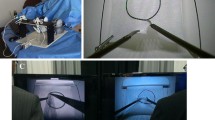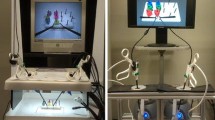Abstract
Introduction
The Fundamentals of Laparoscopic Surgery (FLS) trainer is currently the standard for training and evaluating basic laparoscopic skills. However, its manual scoring system is time-consuming and subjective. The Virtual Basic Laparoscopic Skill Trainer (VBLaST©) is the virtual version of the FLS trainer which allows automatic and real time assessment of skill performance, as well as force feedback. In this study, the VBLaST© pattern cutting (VBLaST-PC©) and ligating loop (VBLaST-LL©) tasks were evaluated as part of a validation study. We hypothesized that performance would be similar on the FLS and VBLaST© trainers, and that subjects with more experience would perform better than those with less experience on both trainers.
Methods
Fifty-five subjects with varying surgical experience were recruited at the Learning Center during the 2013 SAGES annual meeting and were divided into two groups: experts (PGY 5, surgical fellows and surgical attendings) and novices (PGY 1-4). They were asked to perform the PC or the ligating loop task on the FLS and the VBLaST© trainers. Their performance scores for each trainer were calculated and compared.
Results
There were no significant differences between the FLS and VBLaST© scores for either the PC or the ligating loop task. Experts’ scores were significantly higher than the scores for novices on both trainers.
Conclusion
This study showed that the subjects’ performance on the VBLaST© trainer was similar to the FLS performance for both tasks. Both the VBLaST-PC© and the VBLaST-LL© tasks permitted discrimination between the novice and expert groups. Although concurrent and discriminant validity has been established, further studies to establish convergent and predictive validity are needed. Once validated as a training system for laparoscopic skills, the system is expected to overcome the current limitations of the FLS trainer.





Similar content being viewed by others
References
Maithel S, Sierra R, Korndorffer J, Neumann P, Dawson S, Callery M, Jones D, Scott D (2006) Construct and face validity of MIST-VR, Endotower, and CELTS: are we ready for skills assessment using simulators? Surg Endosc 20(1):104–112
Cao C, MacKenzie C (1997) “Direct, 2-D vs. 3-D endoscopic viewing & surgical task performance,” A Symposium on Evolving Technologies: Surgeons’ Performance of Surgical Tasks. J. Sport and Exercise Psychology 19
Adrales GL, Chu U, Witzke D, Donnelly M, Hoskins JD (2003) Evaluating minimally invasive surgery training using low-cost mechanical simulations. Surg Endosc 17:580–585
Peters J, Fried G, Swanstrom L, Soper N, Sillin L, Schirmer B, Hoffman K, Sages FLS Committee (2004) Development and validation of a comprehensive program of education and assessment of the basic fundamentals of laparoscopic surgery. Surgery 135(1):21–27
Powers T, Murayama K, Toyama M, Murphy S, Denham E, Derossis A, Joehl R (2002) House staff performance is improved by participation in a laparoscopic skills curriculum. Am J Surg 184:626–629
Fraser SA, Klassen DR, Feldman LS, Ghitulescu GA, Stanbridge D, Fried GM (2003) valuating laparoscopic skills: setting the pass/fail score for the MISTELS system. Surg Endosc 17(6):964–967
Fried GM (2008) FLS assessment of competency using simulated laparoscopic tasks. J Gastrointest Surg 12(2):210–212
Botden S, Buzink S, Schijven MJJ (2007) Augmented versus virtual reality laparoscopic simulation: what is the difference? World J Surg 31(4):764–772
Sankaranarayanan G, Lin H, Arikatla V, Mulcare M, Zhang L, Derevianko A, Lim R, Fobert D, Cao C, Schwaitzberg S, Jones D, De S (2010) Preliminary face and construct validation study of a virtual basic laparoscopic skill trainer. J Laparoendosc Adv Surg Tech A 20(2):153–157
Chellali A, Dumas C, Milleville-Pennel I (2012) Haptic communication to support biopsy procedures learning in virtual environments. Presence Teleop Virtual Environ 21(4):470–489
Grantcharov T, Rosenberg J, Pahle E, Fench P (2001) Virtual reality computer simulation. Surg Endosc 15:242–244
Reich O, Noll M, Gratzke C, Bachmann A, Waidelich R, Seitz M, Schlenker B, Baumgartner R, Hofstetter A, Stief C (2006) High-level virtual reality simulator for endourologic procedures of lower urinary tract. Urology 67(6):1144–1148
Dang T, Annaswamy T, Srinivasan M (2001) Development and evaluation of an epidural injection simulator with force feedback for medical training. Stud Health Technol Inform 81:97–102
Panait L, Akkary E, Bell R, Roberts K, Dudrick S, Duffy A (2009) The role of haptic feedback in laparoscopic simulation training. J Surg Res 156(2):312–316
Seymour NE, Gallagher AG, Roman SA, O’Bri BMK, Andersen DK, Satava RM (2002) Virtual reality training improves operating room performance results of a randomized, double-blinded study. Ann Surg 236(4):458–464
Ström P, Hedman L, Särnå L, Kjellin A, Wredmark T, Felländer-Tsai L (2006) Early exposure to haptic feedback enhances performance in surgical simulator training: a prospective randomized crossover study in surgical residents. Surg Endosc 20(9):1383–1388
Aggarwal R, Grantcharov T, Eriksen J, Blirup D, Kristiansen V, Funch-Jensen P, Darzi A (2006) An evidence-based virtual reality training program for novice laparoscopic surgeons. Ann Surg 244(2):310–314
“Epona Medical | LAP-X”. http://www.lapx.eu/en/lapx.html. Accessed 26 June 2013
Zhang A, Hünerbein M, Dai Y, Schlag P, Beller S (2008) Construct validity testing of a laparoscopic surgery simulator (Lap Mentor): evaluation of surgical skill with a virtual laparoscopic training simulator. Surg Endosc 22(6):1440–1444
Iwata N, Fujiwara M, Kodera Y, Tanaka C, Ohashi N, Nakayama G, Koike M, Nakao A (2011) Construct validity of the LapVR virtual-reality surgical simulator. Surg Endosc 25(2):423–428
Ayodeji ID, Schijven M, Jakimowicz J, Greve JW (2007) Face validation of the Simbionix LAP Mentor virtual reality training module and its applicability in the surgical curriculum. Surg Endosc 21(9):1641–1649
Salkini MW, Doarn CR, Kiehl N, Broderick TJ, Donovan JF, Gaitonde K (2010) The role of haptic feedback in laparoscopic training using the LapMentor II. J Endourol 24(1):99–102
Gallagher AG, O’Sullivan GC (2012) Human factors in acquiring medical skills; learning and skill acquisition in surgery. In: Gallagher A, O’Sullivan G (eds) Fundamentals of surgical simulation. Springer-Verlag, London, pp 98–118
Arikatla V, Sankaranarayanan G, Ahn W, Chellali A, De S, Cao C, Hwabejire J, DeMoya M, Schwaitzberg S, Jones D (2013) Face and construct validation of a virtual peg transfer simulator. Surg Endosc 27(5):1721–1729
Zhang L, Sankaranarayanan G, Arikatla V, Ahn W, Grosdemouge C, Rideout J, Epstein S, De S, Schwaitzberg S, Jones D, Cao CGL (2013) Characterizing the learning curve of the VBLaST-PT© (Virtual Basic Laparoscopic Skill Trainer). Surg Endosc 27(10):3603–3615
Flinn J, Wood D, Cao C (2013) Technology-based procedure for automatic and objective error measurement in FLS pattern cutting task. In: Proceedings of the Annual Meeting of the Society of Gastrointestinal and Endoscopic Surgeons (SAGES 2013), Baltimore, MD
ISO (1999) Human-centred design processes for interactive systems (ISO 13407:1999). International Organization for Standardization, Geneva
Acknowledgments
This project was supported by National Institutes of Health (NIH) Grant NIBIB R01 EB010037-01. This research was conducted in collaboration with the SAGES FLS Committee.
Disclosures
Dr. Steven, D. Schwaitzberg is a consultant for Stryker and Olympus and member of the advisory board for NeatStitch, AcuityBio, MITI, Cambridge Endo, and Surgiquest. Jeff Flinn and Drs. Amine Chellali, Woojin Ahn, Ganesh Sankaranarayanan, Daniel B. Jones, Suvranu De, and Caroline, G.L. Cao have no conflicts of interest or financial ties to disclose.
Author information
Authors and Affiliations
Corresponding author
Additional information
Presented as an oral presentation at the SAGES 2014 annual meeting.
Rights and permissions
About this article
Cite this article
Chellali, A., Ahn, W., Sankaranarayanan, G. et al. Preliminary evaluation of the pattern cutting and the ligating loop virtual laparoscopic trainers. Surg Endosc 29, 815–821 (2015). https://doi.org/10.1007/s00464-014-3764-7
Received:
Accepted:
Published:
Issue Date:
DOI: https://doi.org/10.1007/s00464-014-3764-7




